Atlantic Monthly Contributors's Blog, page 199
April 1, 2016
The Brilliant Anxiety of Weezer’s White Album

The most unexpectedly emotional music-related experience I’ve had this year came when I was scrolling through Weezer lyrics on the annotation website Genius, of all things. On first hearing their new song “King of the World”—file under “sounds like Weezer”— you might wonder if Rivers Cuomo’s mentions of magazine covers and plane crashes were the result of random, writerly babble. Turns out, they’re references to his wife’s deep phobias, and on Genius she replies, line by line, to his vows to help her deal with them. “We could ride a Greyhound all the way to the Galapagos” goes the song’s chorus, to which Kyoko Cuomo responds, “I felt like you really understand—like, you chose the ground transportation rather than flying. You know that I don’t like airplanes. It’s kind of nice that you know about your spouse, you know what I mean?”
The couple’s back-and-forth is moving for a few reasons, one of which is that it affirms that the highly publicized gimmick about Rivers looking for lyrical inspiration—and just lyrical inspiration—by joining Tinder is not, in fact, a sign of trouble at home. More poignantly, the “King of the World” commentary, and the song itself, encapsulates the often under-appreciated philosophy that Weezer’s been preaching for two decades. Life is anxiety and disappointment; rock and roll is love and passion and fantasy; to use them to cope is glorious and human.
Many reviews for the white album have rightfully identified it as Weezer’s best work in a very long time. The warm reception is quite possibly because their new producer Sinclair, according to this Rolling Stone interview, is obsessed with the band’s early masterpieces and seems to have reverse-engineered their charms in the studio. Fans of Weezer’s blue album (1994) and Pinkerton (1997) will feel acute déjà vu at the sound of this record’s sky-climbing guitar solos and other instrumental touches, like the “Pink Triangle”-esque chimes that kick things off. More importantly, for the first time in a long while with a Weezer release, after a listen or two they’ll be able to look down the tracklist and hum the melody for each of the songs.
That catchiness, one imagines, is among the highest accomplishments that Rivers Cuomo would hope to achieve. The band’s satisfyingly metallic riffs, candy-sweet toplines, and sturdy A/B/A/B song structures want to be seen as hewing to templates: Rivers has talked over the years about painstakingly studying the ingredients of hit pop music, and always has been a very honest critic of his own work. Like, say, Max Martin, he’s a brainy savant whose specialty is in pleasing the masses. Unlike Max Martin, though, he doesn’t sell his talents to more natural avatars of pop-rock fabulousness. Cuomo plays up his insecurities while presiding over a soundtrack to invincibility. He is a wheezer, wailing. He is all of us normals, singing about how music and other drugs make us feel like Buddy Holly and his successors.
The white album sees Cuomo fixating on a number of those palliatives. One is place: Opener “California Kids” is the ballad of a neurotic Bostonian finding mental escape in warmer places—yes, like “Island in the Sun,” yes, like “Surf Wax USA,” yes, with an avalanching chorus. Another drug is new romance: “Wind in Our Sail” imagines mariners in love cursed by their own albatrosses but getting up to fun adventures nevertheless—“no more hyperventilating in wheelchairs,” Cuomo sings. Another drug is drugs, as when the appropriately sludgy “Do You Wanna Get High?” flips a cliche about pill-popping: “It’s like we’re falling in love.”
But drugs don’t last. For all the fist-pump fuel the white album delivers, it also provides a few moments that approach the heartbreak of Pinkerton’s “Butterfly.” “L.A. Girlz,” a deceptively named chuggalong rocker about yearning, hits you sneakily; Cuomo’s voice quivers right along the borderline between hope and fear even as he makes an undisguised declaration of love in the bridge. The closing two songs don’t bother to hide their sadness. “Jacked Up,” a rare sonic departure, uses bordello piano pulse and Cuomo’s falsetto to inject anticipation of regret into a one-night stand: “If I stroke your hair, it’s gonna hurt so much.” The closer, “Endless Bummer,” conveys its title’s sentiment in the traditional way, with acoustic guitars, as Cuomo sings of fading passions and unconquerable OCD.
The admission of neurosis will come as no shock to anyone familiar with Cuomo’s work. But the album does break ground in answering critics who have long glimpsed a kind of chauvinist solipsism in his nebbish confessions: Ever since “I want a girl who laughs for no one else,” the opposite sex in Weezer songs have been objects with little interiority, existing only to soothe the singer’s addled mind. But the panicked near-rapping of “Thank God for Girls” parodies that idea by imagining a big, strong uber-woman shoving a cannoli in her put-upon boyfriend’s mouth. More beautifully, “King of the World,” the song about Kyoko’s fears, reverses the typical Cuomo dynamic. His wife sounds like more of a neb than he is, and his love is what is supposed to save her. “Thank you & I love you, Rivers,” she wrote back.

Who’s To Blame for the Deadly Overpass Collapse in Kolkota?

Police in Kolkata, India, detained Friday five officials of a construction company building the overpass that collapsed Thursday, killing at least 24 people.
The officials, who are being questioned, have not been charged, but the police have opened a case of culpable homicide (similar to manslaughter) against their company, IVRCL.
More than 300 feet of the concrete-and-steel overpass near the city’s busy Girish Park area crashed down Thursday afternoon. It fell on cars, buses, rickshaws, and pedestrians. In all, about 80 people were injured; rescuers with jackhammers and cranes pulled another 100 people from the debris.
It’s unclear what caused the overpass to collapse, but similar disasters in other parts of the country have been attributed to substandard construction material. An IVRCL official tried another tack.
“It’s nothing but a God’s act,” K. Panduranga Rao, the official, told CNN-IBN, a privately owned TV channel. “So far in 27 years we have constructed several number of bridges … it never happened.”
IVRCL, which was commissioned to build the overpass in 2009, missed several deadlines to complete it. Mamata Banerjee, the chief minister of West Bengal state of which Kolkota is the capital, said the company had not given the government a construction plan despite being asked several times for one. Last November, Banerjee had publicly committed to finishing the overpass by November 2016. But the construction company called that deadline unrealistic.
Deadly collapses such as this aren’t uncommon in India. An expanding economy, a growing middle class, and greater prosperity stand beside crumbling infrastructure and urban squalor. According to one estimate, 70 percent of India has yet to be built—and that’s a challenge successive governments have tried to meet, with mixed results. Although some Indian cities and states boast world-class airports, roads, overpasses, and public-transit systems, delayed projects and shoddy construction remains common across much of the country. In 2006, a 150-year-old bridge in the state of Bihar fell on a train, leaving 34 dead. Three years later, a bridge under construction crashed to the ground and killed 30 people in Rajasthan state. And since 2013, five buildings in Delhi and Mumbai have collapsed and killed hundreds.
In Kolkota, meanwhile, officials said the chances of finding anyone alive in the rubble was remote. It’s still unclear how many more people are trapped.

Who’s to Blame for the Deadly Overpass Collapse in Kolkota?

Police in Kolkata, India, detained Friday five officials of a construction company building the overpass that collapsed Thursday, killing at least 24 people.
The officials, who are being questioned, have not been charged, but the police have opened a case of culpable homicide (similar to manslaughter) against their company, IVRCL.
More than 300 feet of the concrete-and-steel overpass near the city’s busy Girish Park area crashed down Thursday afternoon. It fell on cars, buses, rickshaws, and pedestrians. In all, about 80 people were injured; rescuers with jackhammers and cranes pulled another 100 people from the debris.
It’s unclear what caused the overpass to collapse, but similar disasters in other parts of the country have been attributed to substandard construction material. An IVRCL official tried another tack.
“It’s nothing but a God’s act,” K. Panduranga Rao, the official, told CNN-IBN, a privately owned TV channel. “So far in 27 years we have constructed several number of bridges … it never happened.”
IVRCL, which was commissioned to build the overpass in 2009, missed several deadlines to complete it. Mamata Banerjee, the chief minister of West Bengal state of which Kolkota is the capital, said the company had not given the government a construction plan despite being asked several times for one. Last November, Banerjee had publicly committed to finishing the overpass by November 2016. But the construction company called that deadline unrealistic.
Deadly collapses such as this aren’t uncommon in India. An expanding economy, a growing middle class, and greater prosperity stand beside crumbling infrastructure and urban squalor. According to one estimate, 70 percent of India has yet to be built—and that’s a challenge successive governments have tried to meet, with mixed results. Although some Indian cities and states boast world-class airports, roads, overpasses, and public-transit systems, delayed projects and shoddy construction remains common across much of the country. In 2006, a 150-year-old bridge in the state of Bihar fell on a train, leaving 34 dead. Three years later, a bridge under construction crashed to the ground and killed 30 people in Rajasthan state. And since 2013, five buildings in Delhi and Mumbai have collapsed and killed hundreds.
In Kolkota, meanwhile, officials said the chances of finding anyone alive in the rubble was remote. It’s still unclear how many more people are trapped.

Superman, Batman, and the Evolution of the ‘Perfect’ Hero Body

Every spring and summer, one thing moviegoers can reliably count on is a bumper crop of comic-book movies. At this point in time, studios have run through the A-list (Superman, Batman, Spider-Man, The Hulk), hit the B-list (Iron Man, Thor, Daredevil), and are now chugging through the C-list (sorry, Ant-Man, Deadpool, Guardians of the Galaxy et al).
Another unavoidable fact is that these movies will feature actors who undertook rigorous diet and exercise regimens in preparation for their spandex suits. The ritual of actors bulking up or shedding fat for their superhuman roles may feel inevitable now, but the current standard for impossibly brawny comic-book heroes is something of a new development. Over the past few decades, there’s been a substantial amount of fluctuation when it comes to portraying the “perfect” male body. As an infographic published by The Economist reveals, Adam West’s Bruce Wayne, weighing in around 200 lbs, might surprise viewers familiar with Michael Keaton’s Caped Crusader (158 lbs), while both heroes would be dwarfed by Ben Affleck’s Batman (216 lbs and 6’ 4”).
In fact, the changing bodies of Superman, Batman, and other superheroes of the DC and Marvel universes illuminate the ways the ideal male physique has evolved in American pop culture over the decades.
* * *
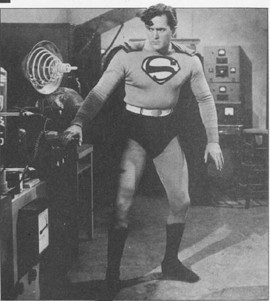
Kirk Alyn as Superman in 1948 (Columbia Pictures)
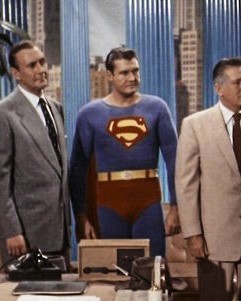
George Reeves as Superman in 1952 (Adventures of Superman)
In the ’50s and ’60s, the film and television industries began their love affair with men in capes. Though these heroes stopped locomotives, jumped over buildings, and retreated to secret lairs, they didn’t have quite the same look (massive shoulders, V-shaped torsos, and rippling abs) as today’s superheroes. Kirk Alyn, the first actor to play Superman in 1948, looked more like a college athlete than an alien Adonis. Later the role was taken over by George Reeves, the quintessential ’50s Man of Steel. Reeves was a broad, barrel-chested hero with a square torso, long limbs, and barely a muscle in sight. But he had a John Wayne-esque brand of masculinity—solid, stable, and strong-jawed—that made him compatible with the times.
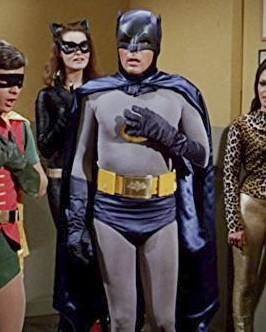
Adam West as Batman in 1966 (20th Century Fox)
In 1966, Adam West took on the role of Batman in the eponymous TV series. West’s runner’s build was sturdy, and out of costume, his Bruce Wayne looked more like James Bond than Charles Atlas. (Incidentally, West was tapped for the role after he played a Bond-inspired spy in a Nestle Quik commercial.) Unlike later Batmans, West didn’t physically transform when he donned his batsuit, morphing from Bruce Wayne to the otherworldly Batman. His simple gray and black outfit only heightened how ordinary his physique was for a man regularly tasked with saving an entire city. West later joked about his appearance on the show when he made a cameo appearance on The Simpsons, saying, “Back in my day, we didn’t need molded bodysuits, [it was just] pure West.”
At that time, Hollywood hadn’t yet discovered skin-tight Lycra or molded plastic pectorals, so costumes were mostly full-body stocking knits. Overall, they revealed little to no hint of the muscles below, highlighting that the physical image of these superheroes was much closer to that of their viewers. In the early 1960s, adult men had an average BMI of about 25, which sits in the “normal” range—a healthy mix of muscle and fat. (Curiously, the average American man today, in the age of uber-buff superheroes, has a BMI of 29, according to the CDC.)
* * *
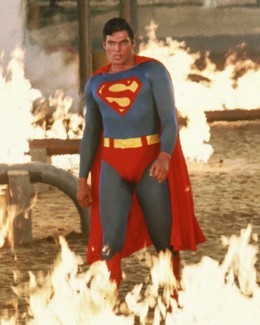
Christopher Reeve as Superman in 1983 (Warner Bros.)
By the late ’70s and ’80s, synthetics were booming. Spandex, polyester, and Lycra, which were invented in the late ’50s, had been refined, and had found new popularity in the disco era. With these materials in high supply, supersuits finally started using stretchy material—a development that would lead to an emphasis on heightened fitness. It was during this time that Christopher Reeve was tapped to become the new Superman. Producers, concerned by Reeve’s naturally tall and slender frame, pressured him to wear fake muscles under his suit. He refused, instead becoming an early adopter of a now-familiar routine: He hired a trainer and put on 30 pounds of muscle. Reeve couldn’t change his bone structure, but he managed to gain biceps, strong shoulders, and the outline of abdominals, all of which were accentuated by his skin-tight outfits. Reeve’s Superman represents a male ideal shaped by the ’80s jogging craze and Jane Fonda’s VHS aerobics.
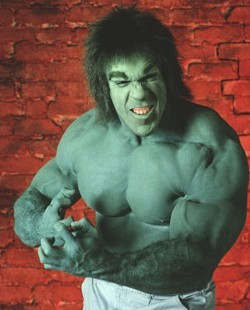
Lou Ferrigno as The Hulk in 1978 (CBS)
In 1978, The Hulk grimaced and flexed his way onto TV screens. Lou Ferrigno’s Hulk resembled a Greco-Roman wrestler, with popping veins and enormous muscles. Unlike other actors who’d played superheroes in the past, Ferrigno came from a bodybuilding background. These two points, Reeve to Ferrigno, represent a limited range of hyper-fit masculine bodies—but it’s still a wider variety than viewers see in many superheroes today. As the Olympics frequently remind audiences, two bodies in peak physical condition can look very different—but it’s a fact Hollywood doesn’t acknowledge much anymore.
* * *
In 1991, a new, alternative rock-influenced aesthetic began to break out from Seattle’s street culture. Nose rings, neon hair, and flannel moved from the fringes into the mainstream, and in the middle of this, Kurt Cobain epitomized a new masculine prototype. “[He] was the antithesis of the macho American man … he made it cooler to look slouchy and loose, no matter if you were a boy or a girl,” said The Fader’s Alex Frank to Vogue. This asexual look was softer and influenced by the same “heroin chic” look that glorified waif-like appearances in women.
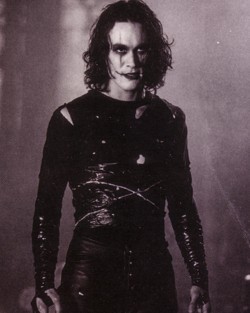
Brandon Lee as The Crow in 1994 (Miramax)
The superhero world saw its own alternative figure emerge when, in the mid-’90s, Brandon Lee brought the dark, brooding figure of The Crow to movie theaters. He looked almost like a strung-out Batman, gothic and lanky with pale skin and messy hair. The movie was a box-office sleeper hit that went on to spark a sequel (despite the tragic death of its lead actor before filming even wrapped). Around the same time, the comic-book character The Sandman, also known as Dream, appeared in an ongoing Vertigo series—he, too, had a skinny-rocker look closer to Sid Vicious than to Superman. (The film version of this character got lost in development having bounced around between various producers and writers. A scathing review of the working script on Ain’t It Cool News in 1998 essentially killed the project.)
In this kind of cultural environment, the muscled heroes of yesteryear started to become objects of comedy or even straight-out mockery. It was this decade that presented Batman & Robin, the most lighthearted and campy of all the movies in the DC franchise. Batman and Robin were also explicitly sexualized in that film, with superhero suits that sported nipples and repeated shots of codpieces and bat buttocks that intensified the comic effect. It was also midway through the ’90s that the popular animated show Ren and Stimpy introduced Powdered Toast Man, a baritone-voiced superhero with gleaming butt cheeks whose tagline to people he rescued was, “Cling tenaciously to my buttocks!”
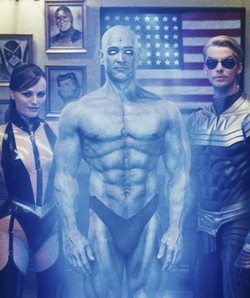
Dr. Manhattan in Watchmen in 2009 (Warner Bros.)
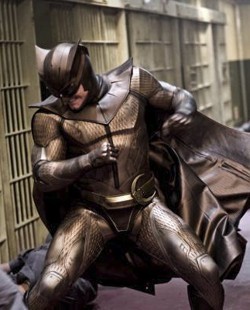
Nite Owl in Watchmen in 2009 (Warner Bros.)
But with the new millennium a kind of truce formed, and a variety of bodies began to be represented. Perhaps no movie represents this better than 2009’s Watchmen. The ensemble here included the ultra-muscled Dr. Manhattan—who sported a computer-generated body modeled after that of the fitness guru Greg Plitt—and the middle-aged Nite Owl, who wore a sculpted outfit that hid his otherwise out-of-shape figure. It’s worth mentioning that neither man is an object of ridicule, and both are love interests for Watchmen’s leading lady. They share the role of protagonist and both claim the audience’s compassion and respect, signaling an increased acceptance that men of all shapes and sizes can be romantic heroes.
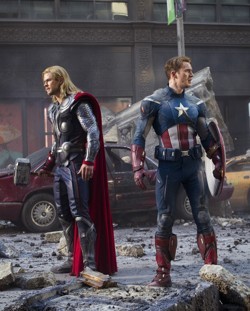
Chris Hemsworth as Thor and Chris Evans as Captain America in 2012 (Marvel)
As for this current decade, superhero stories are like Dr. Octopus’s tentacles, stretching into every direction with multiple spinoffs. But it seems that as studios continue to roll out more superheroes, the leading men are becoming homogenized. Captain America (Chris Evans), Iron Man (Robert Downey Jr.), and pretty much the entire Avenger’s lineup is a fleet of cookie-cutter musclemen. Even when “schlubby” (or snarky) antiheroes appear like Deadpool (Ryan Reynolds) or Peter Quill in Guardians of the Galaxy (Chris Pratt), they still come with an action-ready six-pack. Meanwhile, characters with other body types are often alien or not human at all, as is the case with Peter’s raccoon sidekick.
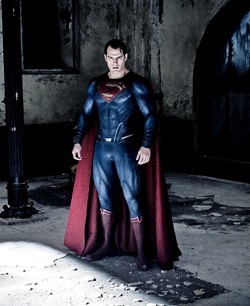
Henry Cavill as Superman in 2016 (Warner Bros.)
The same seems to have held true for Batman v Superman and the upcoming Captain America: Civil War, X-Men Apocalypse, Wolverine, and Guardians of the Galaxy’s sequel. These superheroes are approaching a point of such rigid physical perfection that Hollywood is hovering dangerously close to the uncanny valley, a place of eerie, manufactured humanity. As this ideal becomes duplicated ad nauseam, it might end up disconnecting with viewers—because this echo chamber of muscle men neglects what’s actually compelling about superheroes: the place where “super” and “human” intersect.
Of course moviegoers still expect their superheroes will be better, stronger, and closer to god-like than the average man. But the superheroes of the previous decades could convey superiority along with a dose of humanity. After all, there’s no true heroism without a degree of vulnerability. Even the early radio programs of Superman understood this—that’s why they invented Kryptonite.

Everybody Wants Some!!: The Bros Are All Right

A car packed with college baseball players rolls through a Texas town, its passengers shamelessly trolling for dates. “My Sharona” by The Knack plays in the background as these handsome jocks trade dirty verbal barbs, try out pickup lines, and make mischief in their dilapidated frat house. As such, Richard Linklater’s Everybody Wants Some!! should be a headache, an unnecessary rehash of the ribald college comedy. It’s just the opposite: a delightfully shaggy odyssey through the half-baked thoughts and desires of an amiable gaggle of bros. It wins you over without ever seeming to try, like a goofy joke you can’t help but smile at, and the result is a comedy that deserves its place in Linklater’s pantheon alongside his 1993 cult masterpiece Dazed and Confused.
Related Story

Before Sunrise, 20 Years Later
For a film that isn’t about much in particular, Everybody Wants Some!! is surprisingly plotty, getting its hefty ensemble into plenty of minor scrapes over a weekend as they prepare for another year of college. The 1980-set film, loosely inspired by Linklater’s own brief career as a college baseball player, follows Jake (Blake Jenner), a freshman pitcher settling in with his new team and navigating the hazing rituals, preening rivals, and general pile-up of burgeoning masculinity therein. But Linklater doesn’t seek to explode anything into teen melodrama, or deliver some satisfying arc of personal growth and development. His heroes spend the film bantering about matters big and small, dancing to an eclectic soundtrack, and generally having a good time. Audiences are almost guaranteed to do the same.
Though it’s being billed as a “spiritual sequel” to Dazed and Confused, Linklater’s 1976-set high-school comedy that was also inspired by his adolescence, Everybody Wants Some!! has just as much in common with his less-heralded 2001 work Waking Life. No, it’s not a psychedelic animated film set in the world of dreams, but it does draw upon Linklater’s expert skill with conversation, making the aimless chatter of Jake and his teammates feel like next-level philosophizing. The film revels in the universal experience of that period between adolescence and adulthood, and the moments of insight that could come from articulating ideas great and small. More than the skirt-chasing or the baseball, it’s the talking that’s the thrill of Everybody Wants Some!!
It wins you over without ever seeming to try, like a goofy joke you can’t help but smile at.
This is an undeniably male film—there’s only one major female character, Beverly (Zoey Deutch), a winsome drama student who forms a connection with Jake. But Linklater’s mellow take on dudehood feels like a necessary counter to the puffed-up, toxic masculinity of the present, where cloistered groups of men on the Internet shriek and moan at the idea of their primacy being threatened. The jocks of Everybody Wants Some!! are often stupid, and then just as quickly intelligent or sensitive; even the most dunderheaded among them aren’t one-dimensional stereotypes, and prove themselves capable of moments of (perhaps accidental) genius.
There’s Finnegan (Glen Powell), a verbose charmer on the edge of aging out of college ball, holding onto his last moments as king of the campus. Glen (Tyler Hoechlin) is a genuine prospect who values his status as the team’s athletic star, becoming hyper-competitive about everything from ping-pong games to the proper application of cologne. Willoughby (Wyatt Russell) gets his teammates stoned and waxes lyrical about the chord progressions of Led Zeppelin and Pink Floyd. Jay (Juston Street) is an hilariously aggressive transfer student who in any other film would precipitate a dramatic confrontation. Here, when he butts heads with Glen, he eventually realizes his mistake and apologizes; Glen gives him a pat and assures him they’re cool.
Above all, Linklater wants his audience to have a good time without ever showing them a moment that feels canned. When Glen and friends drive around campus reciting the lyrics to the Sugar Hill Gang’s “Rapper’s Delight,” the director holds for a minute too long, letting the performance go from sweet, to awkward, and then back around. The film’s varied soundtrack reflects the curious cultural moment at the start of the ’80s, and the crash of genres and tastes is reflected in the film’s many dance sequences at local clubs. The guys throw down at a disco, a country jamboree, a punk show, and a musical, equally excited by everything. Linklater has remarked on the relative innocence of America post-Great Society and pre-Reagan, and the ease with which the group’s lone black member Dale (J. Quinton Johnson) interacts with the rest of the largely white cast feels indicative of that.
But Everybody Wants Some!! is nostalgic for more than its specific era: It’s evocative of a moment in growing up, the freedom of leaving home coupled with the low stakes of college life. It’s frequently hilarious and unusually gripping for a film that strives to avoid manufactured drama, and it leaves the viewer with a deep understanding of each character in its teeming ensemble. In short, it’s an effortless cult classic, delivered by a master of the form, and one of the first truly must-see movies of 2016.

The March Jobs Report Brings More Good News

The March jobs report is out, and it’s meeting the modest expectations laid out for it. On Friday morning, the Labor Department reported that the U.S. economy added 215,000 jobs and that unemployment moved up slightly, to 5 percent. Economists were expecting 205,000 jobs to be added and that the unemployment rate would remain at 4.9 percent. All in all, the U.S. economy is looking healthy, with steady job gains for the past 73 months.
January’s jobs report missed expectations, but February’s numbers exceeded them. This month’s revisions had January’s numbers go slightly down and February’s numbers slightly up, but even so the U.S. economy has been adding an average of 209,000 jobs in the last three months.
In the last couple of years, the month of March has borne disappointing jobs reports. But this year’s March report met expectations, with the Labor Department reporting hiring in the sectors of retail, construction, and health care. Employment in mining continued to decline.
One of the most promising signs: In 2016, economists are looking for wages and labor-force participation to improve. And in March, hourly wages rose by 7 cents, bringing wage gain to 2.3 percent for the past 12 months. There’s also good news about the labor-force participation rate, which is up again, to 63 percent.
A lackluster participation rate has caused economists to wonder whether those who lost their job during the recession will return to work. This month’s number is the highest in two years, and indicates that Americans are indeed coming back to the labor force. This is also a source of optimism when accounting for the slight uptick in the unemployment rate, as Americans sitting on the sidelines post-recession was one suspected reason that the rate of unemployment has been so low: Those who haven’t actively looked for a job in the past four weeks aren’t counted by the Labor Department.
Investors have been carefully watching the Federal Reserve for hints about its actions during the rest of the year. On Tuesday, Fed Chairwoman Janet Yellen said at the Economics Club of New York that the FOMC would “proceed cautiously”—which most took as an indication that the Fed would not be raising rates at its April meeting. According to minutes from the Fed’s March meeting, there are two quarter-point increases expected ahead in 2016. The question is whether firm U.S. economic data will be enough to keep the Fed convinced in light of weak global growth.

March 31, 2016
Turkey’s Media Crackdown Knows No Borders

Recep Tayyip Erdogan’s security detail manhandled reporters and protesters at an event at which the Turkish president was speaking.
Turkish media and the president’s critics are by now used to such incidents, but they probably didn’t expect them to happen in Washington, D.C., where Erdogan was speaking at the Brookings Institution.
Erdogan's thugs attack reporters outside @BrookingsInst as Erdogan speaks inside. pic.twitter.com/kg7Ae88qes
— Mahir Zeynalov (@MahirZeynalov) March 31, 2016
Erdogan's detail kick out critical Turkish journo @ademyavuza out of @BrookingsInst This is happening in Washington! pic.twitter.com/UO8tXtV9E2
— Mahir Zeynalov (@MahirZeynalov) March 31, 2016
The altercation with journalists is merely a physical manifestation of what’s been happening to Turkey’s free press since Erdogan was elected president in 2014 (after more than a decade as prime minister). Since then, newsrooms deemed critical by the president have been attacked, journalists arrested and charged with espionage, an opposition newspaper has been seized, and foreign reporters deported and harassed for their coverage. Indeed, Freedom House, the pro-democracy advocacy group, says the press in the country is “not free” following a five-year decline in press freedom. Reporters Without Borders, the media-watchdog group, ranked Turkey 149 out of 180 countries in its 2015 World Press Freedom Index—an improvement from 154th place in 2014.
It’s probably worth pointing out a couple things here: Much of what the Turkish media is experiencing today is similar to what it went through under successive military governments. Erdogan, who is still very popular in Turkey, began his rule in 2003 as a reformer under whom the media thrived.
The situation has changed in Turkey, not least of which is the fact Erdogan is now president and attempting to increase his powers. But the situation around him has changed, too. Turkey’s heavy involvement in the Syrian Civil War (where it supports groups fighting against President Bashar al-Assad) and its campaign against Kurdish rebels, whom it views as terrorists, form the basis of much of the crackdown on media.
Exhibit A in this crackdown is Zaman, the country’s largest newspaper, which is closely linked to Fethullah Gulen, the influential U.S.-based cleric and former ally of Erdogan whom the Turkish president now views as the head of a terrorist movement. Earlier this month, a Turkish court—without providing a reason—placed Zaman under state control, effectively turning an opposition newspaper into a pro-government publication overnight.
#Turkey’s government confiscated one of the country’s last critical voices, #Zaman Daily.. The end of democracy.. pic.twitter.com/t3SbHkHzyB
— Emre Soncan (@e_soncan) March 4, 2016
Then there is the case involving Can Dundar, the editor of Cumhuriyet, and Erdem Gul, the newspaper’s Ankara bureau chief. Their newspaper published a story in May 2015 that alleged Turkey was shipping arms to Islamists in Syria.
Erdogan’s reaction: “The person who wrote this news shall pay a heavy price for it, I won’t just let it go.”
The two journalists were arrested in November and charged with espionage in connection with the story. Their closed-door trial, which began last week, has been adjourned until April 1. The journalists have denied the charges, but face a life sentence if found guilty.
Human Rights Watch, in a statement, said the trial “is about putting journalism itself on trial and is one of the most flawed prosecutions in Turkey in recent times.”
They were among 14 journalists arrested in 2015, double the figure from the previous year. The New Yorker’s Dexter Filkins counts at least 20 reporters who have been imprisoned, including about a dozen Kurdish journalists.
“It’s so hard to get information that we aren’t sure how many journalists have been detained,” Nina Ognianova of the Committee to Protect Journalists told Filkins. “The campaign is unrelenting.”
On Wednesday, that campaign made its way to the U.S. capital.

A Setback for South Africa’s President

South Africa’s highest court ruled Thursday that President Jacob Zuma violated the constitution when he used $15 million in state funds to upgrade his private estate.
The Constitutional Court ordered Zuma to repay the money used for non-security upgrades to his Nkandla home, including a swimming pool, chicken run, cattle enclosure, and an amphitheater. The national treasury will determine the amount owed within 60 days; Zuma has 45 days to pay following that decision.
Zuma “has noted and respects” the court decision, a government spokesman said in a statement.
“The President appreciates and reaffirms the powers of the Constitutional Court as a final arbiter on matters of the Constitution in the Republic of South Africa,” the statement said.
In 2014, South Africa’s public protector, Thuli Madonsela, issued a report that found funds were used for non-security renovations and recommended that Zuma repay the money. But Zuma said the public protector’s recommendation was advice, not an order, and claimed other officials authorized the upgrades without his knowledge. He then ordered his own investigations conducted by the police and public-works ministries. One report described Zuma’s swimming pool as a reservoir to fight fire and, therefore, a security measure. Two opposition parties—Economic Freedom Fighters (EFF) and the Democratic Alliance (DA)—appealed to the Constitutional Court.
On Wednesday, the Constitutional Court unanimously found Zuma’s actions unconstitutional. The chief justice, Mogoeng Mogoeng, said by “failing to comply with the remedial action, the president thus failed to uphold, comply, and respect the constitution.” He described Zuma’s denials and investigations as “substantial disregard” for Madonsela.
“The president may have been acting on wrong legal advice, in good faith,” he added. “But the illegality still stands.”
The scandal is the latest involving Zuma, who has, over the years, been accused of rape, corruption, and other misdeeds. The charges haven’t stuck, but the taint has. Wednesday’s ruling ends a six-year saga of reports, denials, and exonerations. South Africa’s opposition said Wednesday they would move to impeach Zuma, who has vowed to stay in office.
Julius Malema, the leader of EF, called Wednesday’s developments an “opportunity for South Africa to unite and remove a criminal from office.”
“Parliament has failed our people‚” he said at a news conference. “Let South Africa elect honorable people who will uphold the constitution.”
The DA also blamed Parliament, where Zuma’s ruling African National Congress holds a majority.
“Indeed it has been our assertion that Parliament failed to satisfy its constitutional mandate to hold the Executive accountable” to the Constitution, it said in their joint statement calling for Zuma’s impeachment.
Madonsela called the ruling “better late than never” at a press conference.
“Now the Constitutional Court has confirmed I did my job properly,” she said, “and it is someone else’s job to see what happens next.”

A ‘Nude’ Shoe for Every Woman

Whether the Duchess of Cambridge herself can fairly be thanked (or blamed) for the trend, the Kate Middleton effect is real: The “nude” pump has become, in recent years, a go-to shoe for many women. It’s simple, and elegant, and a nice option for those who want a matches-basically-everything alternative to black. As the stylist service Urban Darling puts it: “When it comes to wardrobe staples, the nude pump in particular, is at the top of my list.”
Related Story

When Diversity Is a Spokesmodel
Except: Nude, as a concept and a color, is fraught for obvious reasons, full of outdated assumptions about skin tones and defaults. And pump, for that matter, is a little fraught, too: While Kate Middleton favors stilettos, what of the many, many women out there who want the slip-them-on-without-a-thought ease of nude shoes, without the teetering heights?
Enter Christian Louboutin, the consummate designer of luxury footwear. In 2013, Louboutin, taking into account the fact that the traditional approach to “nude” has excluded many of his customers, created a collection of nude styles—five shades in all. In 2015, he expanded the collection to seven shades. Yet the collection premised on inclusivity—whose “Nudes” range from “porcelain” to “deep chocolate” in hue—were missing a crucial component. While they included stiletto pumps and t-straps … they did not include practical, comfortable flats.
Now, Louboutin has rectified that. The latest item in his ever-expanding “Nudes” collection is a ballerina flat named, in vaguely anthropomorphic Louboutinian parlance, “Solasofia.” It costs $595, and is made of a soft nappa leather that is designed to mimic, The Cut notes, the feeling of skin.
Hamilton: Casting After Colorblindness

Hamilton might be one of the rare cultural products that comes close to actually earning the phrase “universal acclaim.” Barack Obama says it’s the one thing he and Dick Cheney agree on. The National Review loves it; The New York Times loves it. The praise is so unquestioned that The Awl has an ongoing series spotlighting even the mildest hint of dissent. Deadpans Alex Balk, “On any of those rare occasions when you get a glimpse of someone wondering whether Hamilton might not be the greatest thing that ever happened in 50,000 years of culture do you find yourself stunned, surprised, or fearful for the heretic’s safety?”
But earlier this week, it appeared that backlash to the musical may have finally arrived when a New York City lawyer objected to a Hamilton ad encouraging “non-white” performers to try out for lead parts. One of Hamilton’s signature features is that its has people of color playing Alexander Hamilton, George Washington, Thomas Jefferson, James Madison, and their contemporaries. Accusing the casting call of being discriminatory might seem to raise the idea that the play itself is discriminatory, and it’s not hard to imagine how the conversation would go from there. In an era when the lead Republican candidate is frequently understood to voice the resentment of whites who see their longstanding supremacy in American society threatened—an era where comments sections roil with apocalyptic mentions of “reverse racism” and “black privilege”—the notion of America’s founders de-whitened for a blockbuster Broadway show would seem like inevitable cause for a round of cultural warfare.
But: The casting-call criticism appears not to have been a referendum on the play itself. It was mostly a “semantic” issue, reports Michael Paulson in The New York Times. Individual characters can, under employment law and under union rules, be described as having a specific race, gender, and age. But any actor should be able to try out for any role. Hamilton’s producers said they would reword their casting call to reflect that distinction, but would not change anything about the racial makeup of the cast. “It is essential to the storytelling of Hamilton that the principal roles, which were written for nonwhite characters (excepting King George), be performed by nonwhite actors,” they wrote in a statement.
The episode highlights just how intentional, and arguably radical, Hamilton’s makeup is. “Colorblind casting” has been an industry phrase for decades now, and while it has a few competing definitions, the common public understanding is that it refers to casting directors disregarding skin color as they fill roles. Shonda Rhimes, the creative force behind Grey’s Anatomy, Scandal, and How to Get Away With Murder—all shows that break with Hollywood’s whitewashed history—is a proponent of this kind of casting, and it is how a London production of Harry Potter and the Cursed Child ended up with a black Hermione. But it has implications that both sides of the ideological spectrum can take issue with. Earlier this year, following a few incidents where supposed colorblindness led to white actors playing parts written as non-white—including a portrayal of Martin Luther King, Jr.— more than 1,000 playwrights signed a column published in American Theatre arguing for “color-conscious” casting instead.
Hamilton does not merely allow for some of the Founding Fathers to be non-white. It insists all of them be.
Hamilton is not, by the common definition, colorblind. It does not merely allow for some of the Founding Fathers to be played by people of color. It insists that all of them be. This insistence is part of the play’s message that Alexander Hamilton’s journey from destitute immigrant to influential statesman is universal and replicable (and comparable to the life stories of many of the rappers who inspired Hamilton’s music). Obama, recently hosting the cast at the White House, gave the standard interpretation: “With a cast as diverse as America itself, including the outstandingly talented women, the show reminds us that this nation was built by more than just a few great men—and that it is an inheritance that belongs to all of us.”
That last line might sound like a platitude, and there have been times in history when it may have really been one. But movements like Black Lives Matter, and renewed calls for the consideration of reparations, are built on the idea that “all” remains an unfulfilled promise—and that fulfillment can only come by focusing on helping the specific populations that suffer greatest from America’s many inequalities rooted in oppression. The national discourse in the past few years has demonstrated that this remains a controversial idea. While Hamilton does not explicitly take a side, the simple fact of its casting suggests which way it probably leans. As the production goes on tour outside New York City in the coming years, it will spread its argument about America—and perhaps also, finally, start a few.

Atlantic Monthly Contributors's Blog
- Atlantic Monthly Contributors's profile
- 1 follower



